Day 3 of a 3-day Early Winter Tour in Norfolk. It was forecast to rain for much of the day today and fortunately at least that was wrong. However, there was some light sleet still first thing and some light drizzle late afternoon and it remained very grey all day.
We started the day down at Blakeney. It was still sleeting a little when we parked at the west end of the quay and got a surprise when we got out of the minibus and what we thought was a puddle was actually sheet ice overlain with fresh sleet. The gravel parking bay was black ice and treacherous! We parked again where it was a little better, and kept to the road which was safer, until we got onto the tarmac quay. There were a few Wigeon, Teal and Brent Geese along the edge of the harbour channel and a Grey Plover on the sand the other side.
The National Trust car park was sheet ice too, so we went out onto the road again and up onto the bank the other side. The path was not much better, so we walked gingerly out along the grass either side. There were several Marsh Harriers up over the saltmarsh beyond the harbour channel and we had a quick glimpse of a Merlin chasing pipits in the distance towards Morston, which unfortunately did not reappear. A large flock of Brent Geese were feeding on the saltmarsh close to the path before they were spooked by an alarm calling Curlew and flew out into the middle.
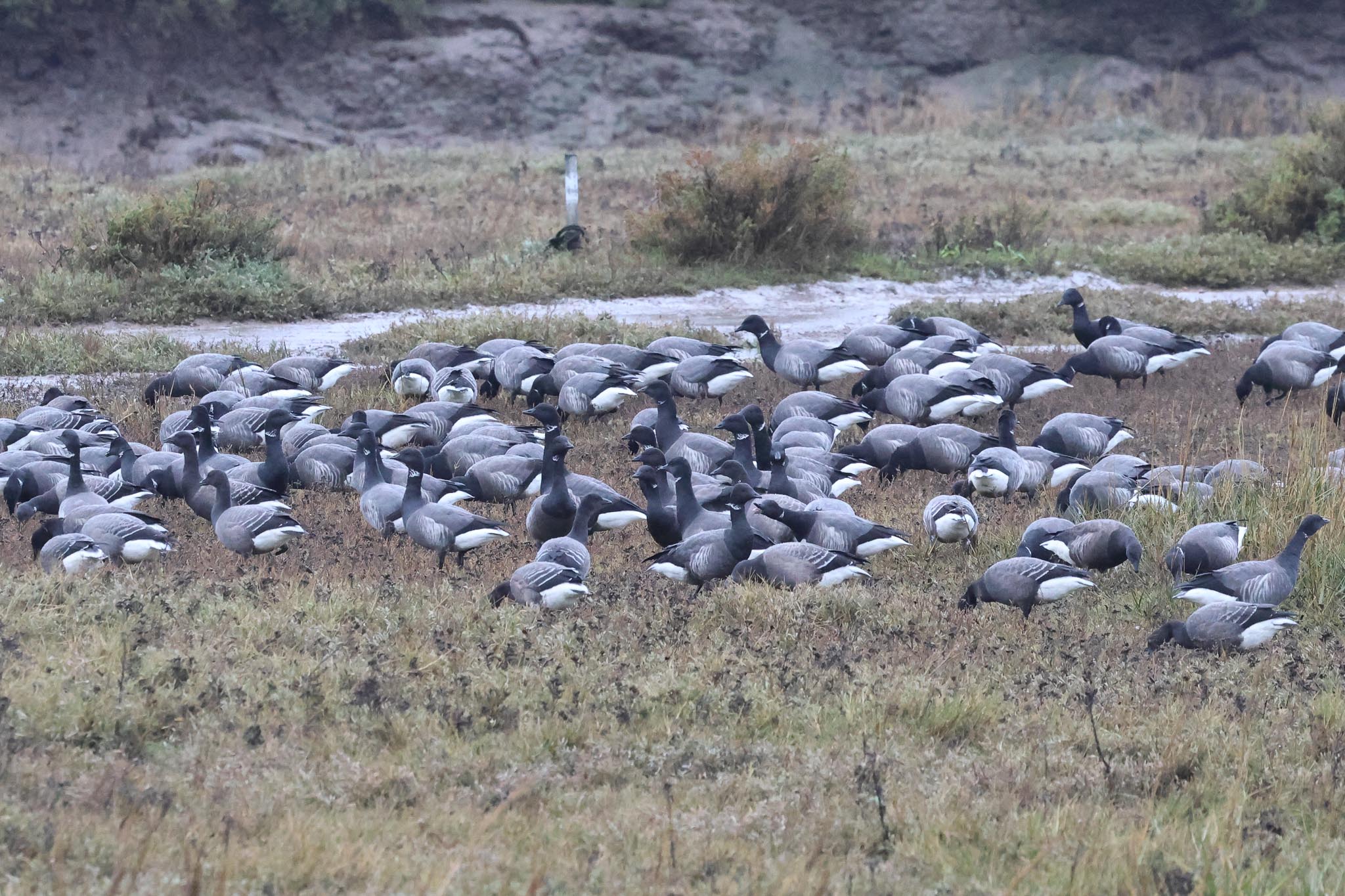
We made our way slowly out along the bank. There were quite a few Canada Geese out on the grazing marsh behind Little Barnett and another small flock of Brent Geese too. In with the Brents, we could see three Barnacle Geese too so we stopped to get the scope on them. We were aiming to get out to the NW corner of the Freshes bank, but it was getting increasingly icy so we stopped short and scanned the harbour. A couple of Red-breasted Mergansers surfaced briefly in between the boats and we could see lots of waders further up on the open mud, Dunlin, Grey Plover, Redshank and Curlew.

We were hoping to catch up with the Twite here, but at first all we saw was a flock of Linnets which flew round and round out over the saltmarsh and eventually landed so we could confirm what we thought they were. There were a few Skylarks, Reed Buntings and pipits flying round too, but after a while another flock of small finches appeared out by the edge of the channel, bouncing up and down like they were on elastic. They landed on the stays of the mast of a yacht which was sticking up out of the suaeda and we could get the scope on them and confirm they were indeed the Twite we had been waiting for.
The Twite quickly dropped down into the vegetation below, then flew up again and disappeared out into the middle of the harbour. We thought that might be it, but the next thing we knew that were flying back in and landed again on the mast. This time they lingered there a little longer, allowing most of the group a chance to look at them in the scope. The light wasn’t great, but you could just about catch the yellow bill on one or two.
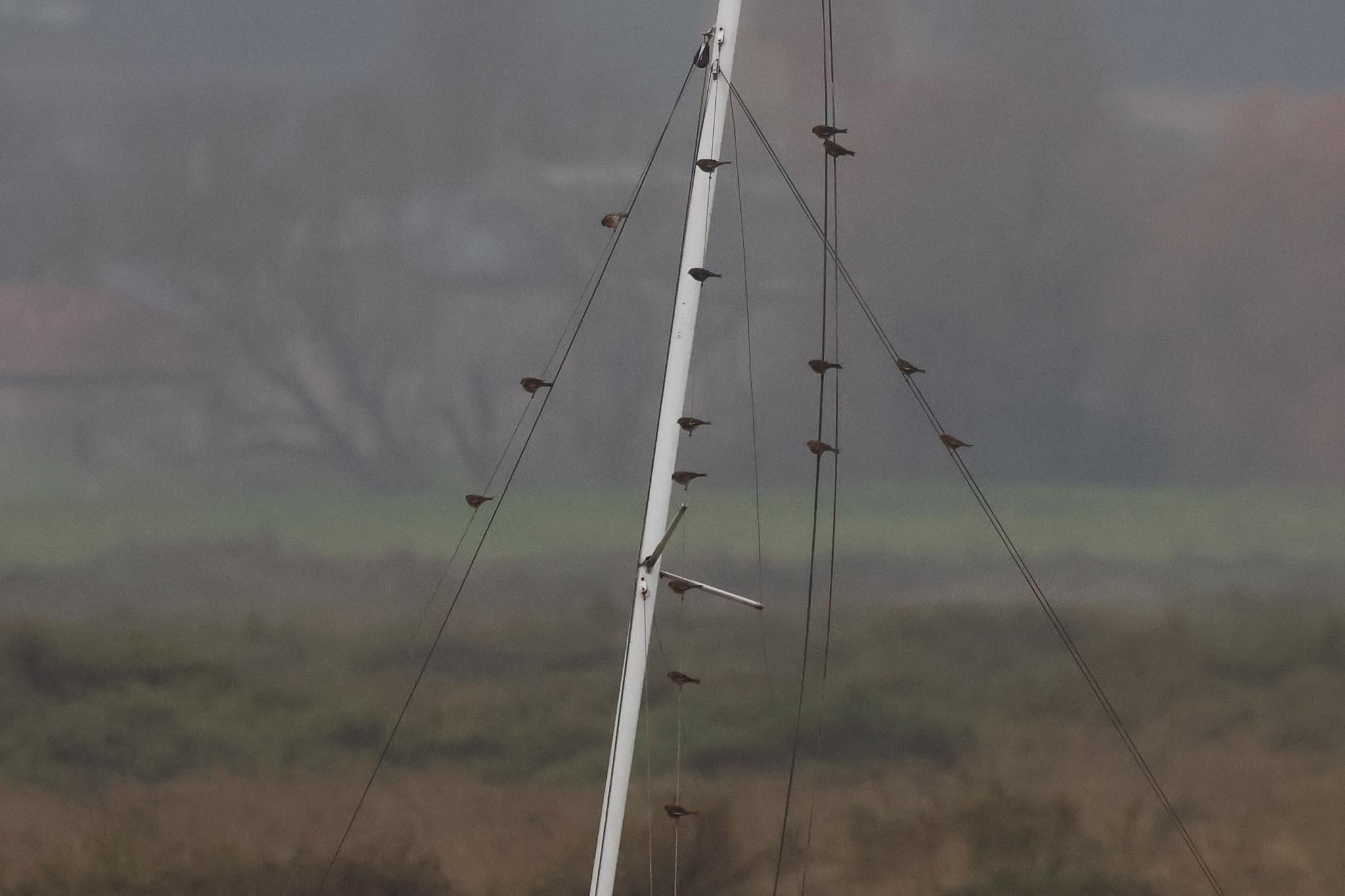
Having seen the Twite, we decided to head back to the minibus to warm up. On the way, the ice seemed to have started to melt and it stopped sleeting and began to brighten up a touch from the west. While we stopped to use the facilities opposite the NT car park, we scanned the saltmarsh out beyond the harbour. There were still several Marsh Harriers up and then we noticed a smaller, slimmer one which appeared briefly – a ringtail Hen Harrier. It came up again and we managed to get it in the scope, but it was keeping typically low.
We thought we might have a better view from the bank at the west end of the quay, so we hurried round. As we passed the boats, a Kingfisher shot out from behind one of them and disappeared into a small channel opposite. We found it perched on the rope tying up another smaller boat hidden in the channel. There was no further sign of the Hen Harrier now, but scanning through the goose flocks, we did find an interesting Brent Goose in with one of the flocks, possibly a Dark-bellied Brent x Black Brant intergrade.
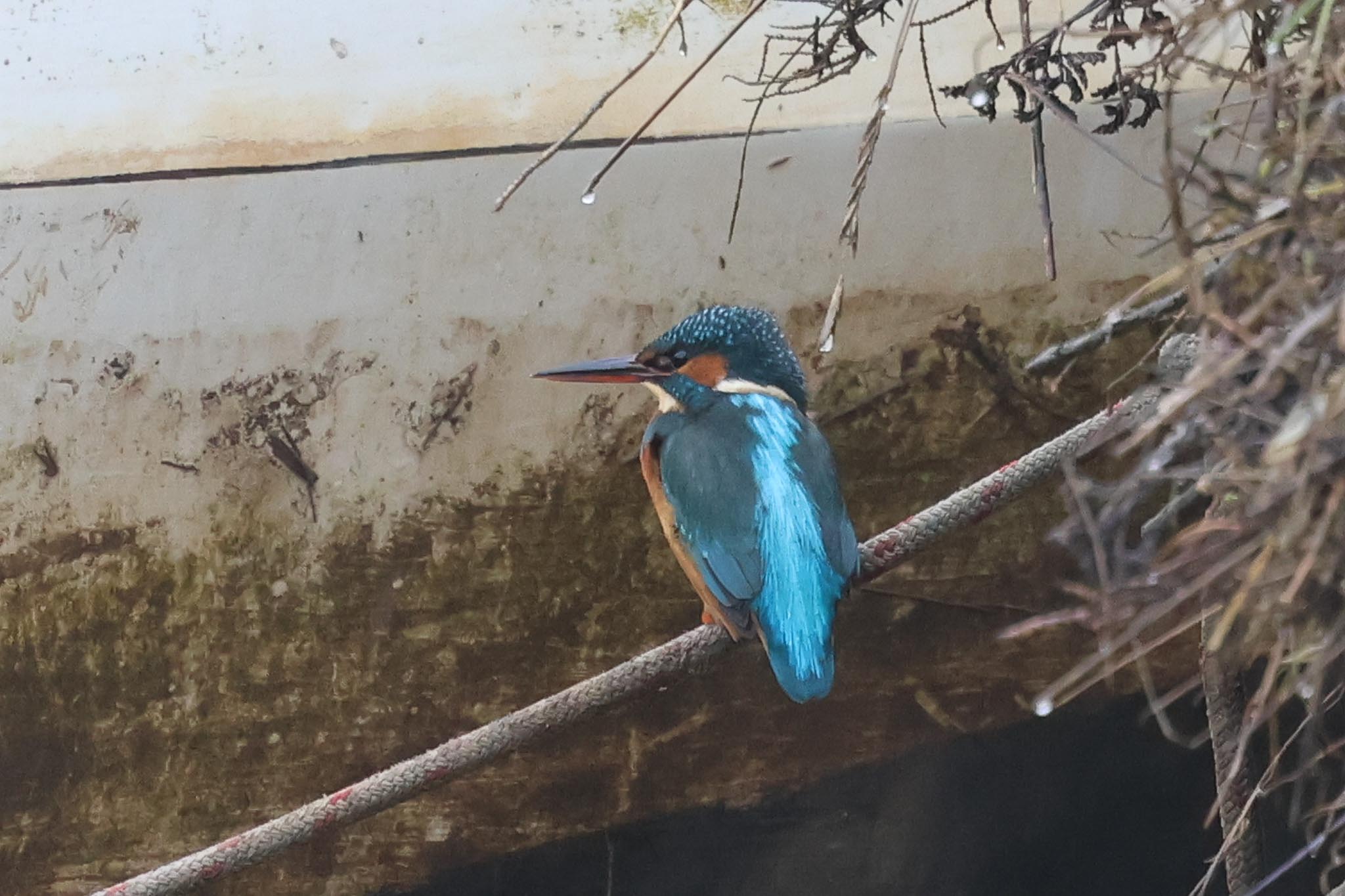
Back in the minibus, we drove west to Stiffkey. The Glossy Ibis had been reported again yesterday on the flood by the coast road, so we parked in the layby on the corner and set off to walk down the permissive path to see if we could find it. A large flock of Woodpigeons came out of the trees and we picked out several Stock Doves in with them. There were lots of Curlews and several Lapwings in the grass field opposite. Down at the flood, we had just started to scan, when the Glossy Ibis walked out from behind the bushes on the east end of the flood, close to the footpath. That was nice and easy!
After a good look at the Glossy Ibis through the scope, we had a quick walk down the footpath to check the pools further along. The Ibis was even closer from here, at least until it was flushed by a cow, but there were not many waders today – just a couple of Lapwing, a Redshank and a Curlew. A flock of Long-tailed Tits was high in the trees above us. We turned to walk back, and a Goldcrest was feeding in the tangled branches above the path.
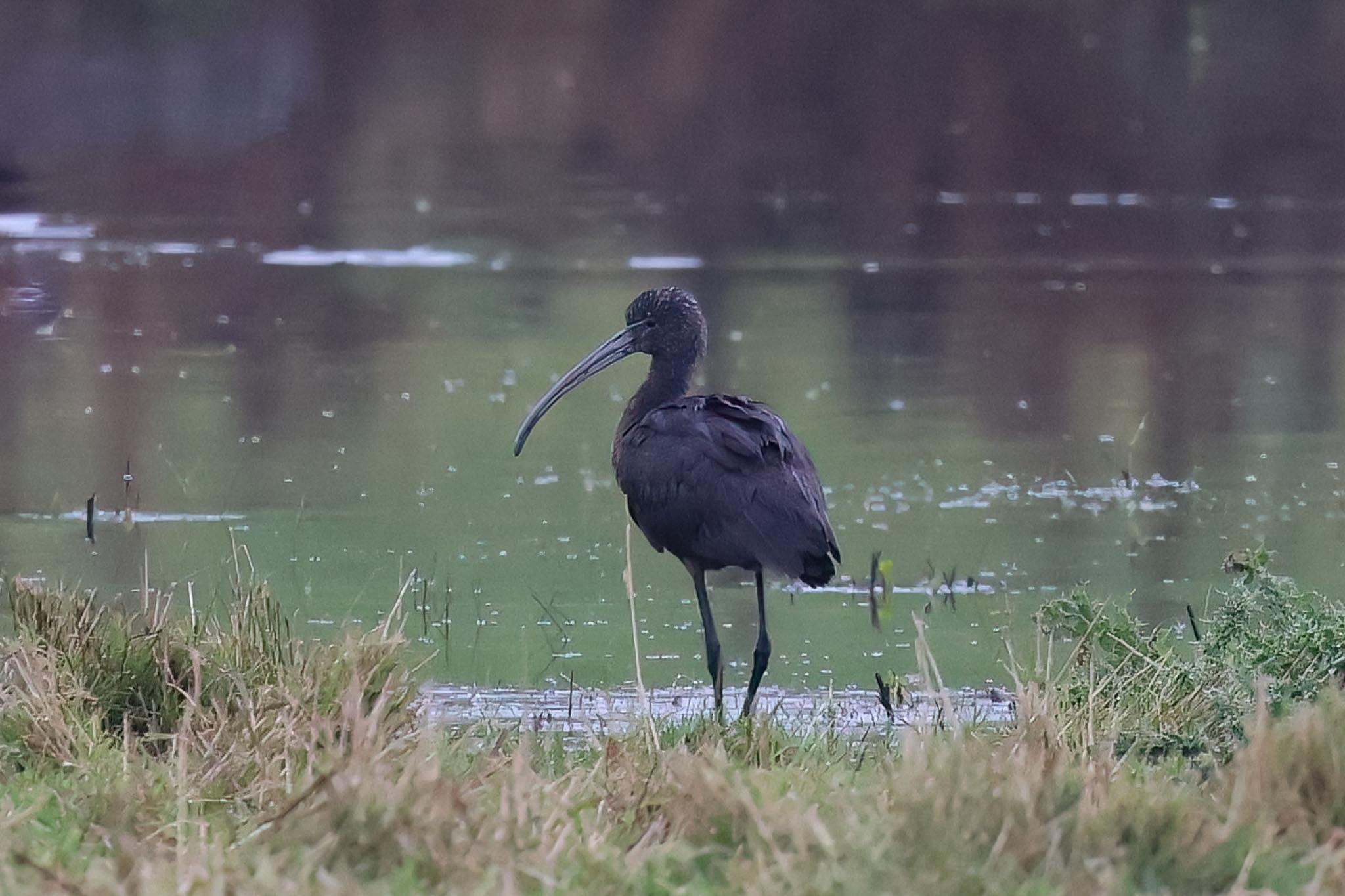
There was still some time before lunch when we arrived at Holkham. Having had our visit cut short by the heavy sleet on Friday, we thought we might have a quick look at the sea today. As we walked out around the saltmarsh again, the Shorelarks were in the same place we had seen them before, at least until they were flushed by a couple of loose dogs and flew off across the Gap. A couple of Scandinavian Rock Pipits flew up calling and landed again on the saltmarsh, where they disappeared back into the vegetation.
Looking out through the Gap, we could see thousands of Common Scoter which came up from the sea and flew round before appearing to move off west. When we got out to the dunes we could see why – a shrimp trawler was ploughing across the bay, presumably doing considerable damage to the seabed and churning up the shellfish which the scoter had gathered here to feed on. There were still lots of Common Scoter out on the sea, but they were now scattered more widely and most of them were much more distant.
We scanned the sea from the top of the dunes. There were a couple of Great Crested Grebes offshore, fewer than we would normally expect to see here, but initially we struggled to find a single diver. Eventually we picked up a very distant Great Northern Diver a mile or two to the west, and then a single Red-throated Diver just off the beach only a little bit closer.
As the shrimp trawler ploughed off east, the Common Scoter slowly started to come back in a little closer. Now we picked up four Velvet Scoter flying in with them, the white in their wings instantly giving them away. They landed slightly separate to the Common Scoter flock at first, which made them easier to see, but then swam in to where the flock were diving.
The shrimp trawler had turned around and was heading back to where all the ducks were feeding. It was time for lunch too, so we decided to head back. As we passed the cordon, we could see someone scoping the far end. As we scanned across, a flock of small birds flew round – we counted 14, one more than the 13 Shorelarks we had seen earlier, and as they landed, we could see one was a smaller Snow Bunting which had joined with them.
Back at the Lookout, we stopped for lunch on the picnic tables. It was still dry and the temperature seemed to have gone up a few degrees, even if it was still rather grey. Afterwards, we still had a little time before we wanted to be at Warham, so we went to look for White-fronted Geese. As we drove along the coast road, we could see lots of geese in the field by the road so we turned round and parked in the layby. We counted at least 77 White-fronted Geese, with a smaller number of Greylags and a single Pink-footed Goose for comparison. We admired the distinctive black belly stripes of the adult White-fronted Geese.
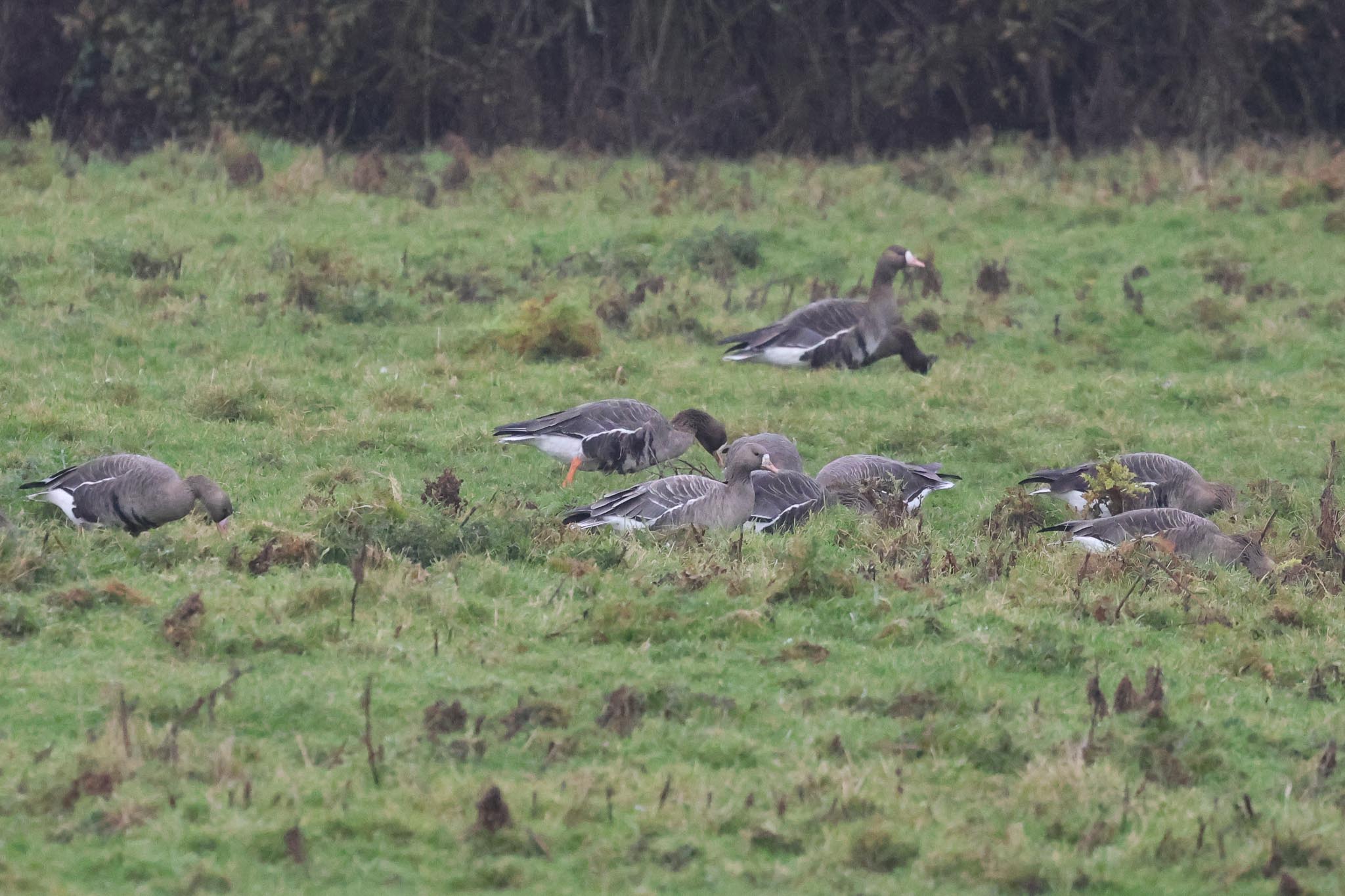
We were hoping to catch up with the Pallid Harrier coming in to roost at Warham this afternoon, so we headed round to Garden Drove. When we got down to the edge of the saltmarsh, it hadn’t been seen yet so we thought we might be in with a good chance. The light was already quite gloomy, but we quickly picked up a Merlin flying across the back of the saltmarsh and scanning with the scope, we found it perched distantly on a bush.
There is normally quite a bit of harrier activity here in the afternoon, but we just had a single Marsh Harrier which flew across the saltmarsh before it started to drizzle. It was only light, but it seemed to put a cap on any more activity – we continued to scan, but it seemed like we were going to be out of luck. We waited until the other highlight of the evening here – we heard the calls of Pink-footed Geese behind us and turned to see several thousand flying in over the fields. They were a bit to the east of us today, as we watched them drop down over the saltmarsh and out towards the beach.
The light was going, so we started to walk back. Another wave of Pink-footed Geese came in over the field beside the track, then another further to the east again. It is always a nice way to end the day, watching and listening to the Pinkfeet coming in to roost, but there was one last surprise tonight. As we drove back down towards the coast road, we could see a shape in the headlights on the track ahead of us – a Woodcock. We slowed and then it flew up in front of us, over the hedge and dropped into the field the other side.
It had not been the best of weather this weekend, but we had made the most of it and had seen a load of good birds too, despite the best efforts of the conditions to put us off.
















